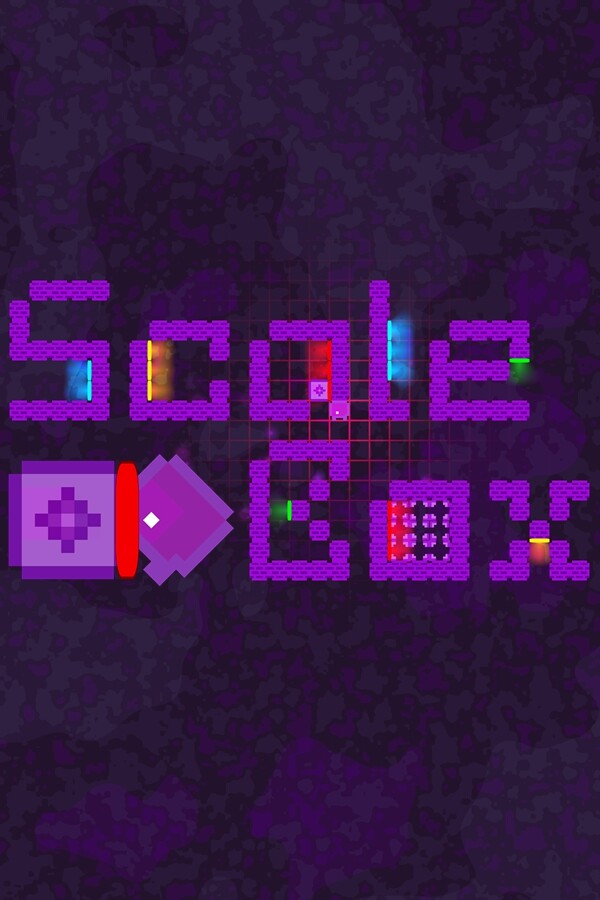ScaleBox

Difficulty : 4/5 (Very Hard)
Global : 3/5 (Very Good)
ScaleBox may look like an easy and small game at first glance, but oh was I wrong.
Do you like hard sokobans? Thinking with portals?
The concept of ScaleBox is pretty simple, you and the boxes you push can grow bigger or smaller when entering portals. However, this leads to a lot of implications that render the game very challenging; I think I’ve never seen the grid-based aspect of a sokoban game being exploited like that.
ScaleBox has a very smooth difficulty curve, each chapter purely gets harder and harder while always keeping the main route balanced so you can always progress. Even in later chapters, you’ll still get pretty simple puzzles thrown in the mandatory puzzles, the very challenging ones are pretty much always optional.
So let’s talk about how the game works exactly.
The goal of each puzzle is simply to correctly fill all required cells with a box. Do note that a 2×2 box is too big for a 1×1 cell for example, you need to place exactly what’s required.
The smallest state in which you can be is a 1×1 box. It’s the more practical state as you usually don’t need to bother about the lack of room, you can push a 1×1 box and set things up like you want. You’ll quickly find out that a lot of puzzles allow and want you to eventually grow to a 2×2 box, this can be done when there’s a double portal somewhere in the level. Simply enter the corresponding entrance portal and you’ll exit out of the double portal as a 2×2 box. Growing bigger is useful and annoying for a lot of reasons. You can now push up to 4 boxes worth of space (a 2×2 box or four 1×1 boxes), but navigating through the puzzle becomes a lot harder. If the entrance portal was of size 1×1, you can return back to the 1×1 size by entering the double portal. Alternating between sizes is the bread and butter of ScaleBox, and you can even grow bigger than a 2×2 box.
ScaleBox surprised me with how varied its puzzle design is. Although two kinds of puzzles are clearly more used, the developer didn’t hesitate to try things and regularly offer unique puzzles.
One of these two kinds involves extreme precision while being a 2×2 box. It’s about correctly aligning boxes, maybe it doesn’t sound that bad but try to imagine how a 2×2 box moves. As you can also find ways to block your movements 1 cell earlier, a lot of alignment problems arise, and ScaleBox likes them a lot.
The other kind, and the most used puzzles in the game, involves finding how to correctly rotate portals and push bigger things with them. You can only push things equal to your weight, but exiting a portal actually applies a force that can push anything. Rotating portals can be done if you push a box with a portal on it (of course the portals are not just on the walls huh) into another portal.
Now imagine your box has a portal on the bottom and you need to push it up… heh no you can’t, you’ll just go inside. Except if you’re bigger than the portal, which is another example of why alternating between sizes is important.
As you can probably see, ScaleBox is very complex. And you completely feel it while playing, the mind-bending nature of the portals combined with very precise setups and inspired puzzle design leads to very challenging puzzles.
Very hard games are my thing, but I felt like ScaleBox was perhaps too convoluted sometimes, taking out a bit of the fun. The subtleties of the rules are not always intuitive, and a good amount of puzzles are so hard to anticipate that you’ll need to experiment a lot.
So yeah, nothing too bad, just be sure that you like this kind of game if you’re interested. Though to be honest, ScaleBox is so cheap for the amount of content you get, you might as well just try it.
I encountered one small bug while in size 1×1, I sometimes bonked on a box that I should’ve pushed. Once again it’s reeeeally minor, I don’t think it changed anything and it only happened sometimes once after undoing.
I’m starting to repeat myself now, but you can’t undo after a restart. Seems like nothing, but it’s actually really useful in sokoban games and I would’ve appreciated it was in the game.
The puzzles are sometimes big, especially when they involve 3×3 or 4×4 boxes. It’s not a problem in itself, but getting a global view of the puzzle is impossible when in size 1×1 or 2×2, and I like to be able to see everything and think. I spoke with the developer about a puzzle that would be ruined if what I’m about to say is implemented so I don’t think it’ll happen, but a free camera mode would be useful. Or perhaps just the ability to zoom out whenever you want.
And I think that’s all! ScaleBox is a very good game that offers some very, very challenging stuff. I do think my playtime (~34 hours) is a bit inflated because I wasn’t fully focused all the time while playing, but that still says a lot as there are only 100 puzzles in total.
Recommended.
Developer: EGGNISI
Publisher: EGGNISI
Platform: Steam – Windows
Release Date: June 20, 2025
